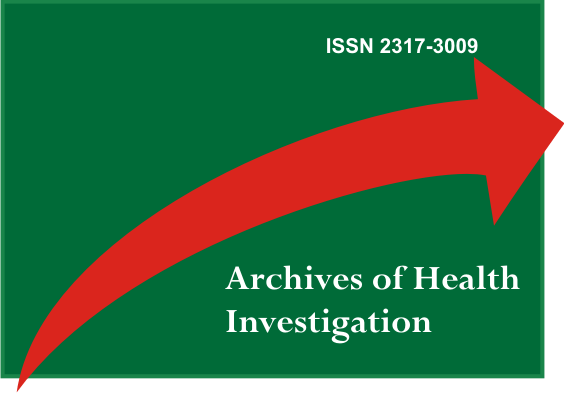Lesões cervicais não cariosas: protocolo clínico
Resumen
As lesões cervicais não cariosas são cada vez mais frequentes acometendo tanto jovens adultos e idosos sendo considerado um problema de saúde pública. Prevenir a incidência dessas lesões, elaborar um diagnóstico, eleger uma técnica restauradora precisa e prevenir sua falha e progressão são considerados grandes desafios clínicos. O objetivo deste artigo é descrever o protocolo de um caso clínico em lesão cervical não cariosa utilizando resina composta.Descritores: Abrasão Dentária; Erosão Dentária; Protocolos.
Descargas
Citas
Osborne-Smith KL, Burke FJ, Wilson NH. The aetiology of the non-carious cervical lesions. Int Dent J. 1999;49(3):139-43.
Lee WC, Eakle WS. Stress induced cervical lesions: reviews of advances in past 10 years. J. Prosthet Dent. 1996;75(5): p.487-94.
Piotrowski BT, Gillette WB, Hancock EB. Examining the prevalence and characteristics of abfraction like cervical lesions in a population of US veterans. J Am Dent Assoc. 2001;132 (12):1694-701.
Lee WC, Eakle SW. Possible role of tensile stress in the aetiology of cervical erosive lesions of teeth. J Prosth Dent.1984; 52(3):374-9.
Braem M, Lambrechts P, Vanherle G. Stress-induced cervical lesions. J Prosthet Dent. 1992; 67(5):718-22.
Pintado MR, Delong R, Ko CC, Sakaguchi RL, Douglas WH. Correlation of noncarious cervical lesion size and occlusal wear in a single adult over a 14-year time span. J Prosthet Dent. 2000;84(4):436-43.
Levitch LC, Bader JD, Shugars DA, Heymann HO. Non-Carious cervical lesions. J Dent. 1994;22(4):195-207.
Oginni AO, Olusile AO, Udoye CI. Non-carious cervical lesions in Nigerian population: abrasion or abfraction? Int Dent J. 2003;53(5):275-9.
Borcic J, Anic I, Urek MM, Ferreri S. The prevalence of non-carious cervical lesions in permanent dentition. J Oral Rehabil. 2004;31(2):117-23.
Pegoraro LF, Scolaro JM, Conti PC, Telles D, Pegoraro TA. Noncarious cervical lesions in adults: prevalence and oclusal aspects. J Am Dent Assoc. 2005;136(12):1694-700.
Grippo JO. Abractions: a new classification of hard tissue lesions of teeth. J Esth Dent 1991;3(1):14-9.
Gallien SG, Kaplan I, Owens BM. A review of noncarious dental cervical lesions. Compendium. 1994;15(11):1366-71,1374.
Academy of Operative Dentistry. Non-carious cervical lesions. Recommendations for clinical practice. Oper Dent. 2003; 28(2):109-13.
Turkun LS. The clinical performance of one-and two-step self-etching adhesive systems at one year. J Amer Dent Assoc. 2005; 136(5):656-64.
Kina M, Kina, J, Almada EC, Kina JR. Lesão cervical não cariosa: relato de um caso clínico. Rev Assoc Paul Cir Dent. 2010; 64(5):356-60
Swift EJ Jr, Perdigão J, Heymann HO, Wilder AD Jr, Bayne SC, May KN Jr, et al. Eigtheen-month clinical evaluation of a filled and unfilled dentin adhesive. J Dent. 2001;29(1):1-6.
Van Meerbeek B, Kanumilli PV, De Munck J, Van Landuyt K, Lambrechts P, Peumans M. A randomized, controlled trial evaluating the tree-year clinical effectiveness of two etches & rinse adhesives in cervical lesions. Oper Dent 2004; 29(4):376-85.
Loguercio AD, Bittencourt DD, Baratieri LN, Reis A. A 36-month evaluation of self-etch and etch-and rinse adhesives in noncarious cervical lesions. J Am Dent Assoc. 2007;138(4):507-14.
Van Dijken JWV. Clinical evaluation of three adhesive systems in class V non-carious lesions. Dent Mater. 2000;16(4):285-91.
Baratieri LN, Canabarro S, Lopes GC, Ritter AV. Effect of resin viscosity and enamel beveling on the clinical performance of class V composite restorations:three-years results. Oper Dent 2003; 28(5):482-7.
Perdigão J, Carmo AR, Anauate-Netto C, Amore R, Lewgoy HR, Cordeiro HJ, et al. Clinical performance of a self-etching adhesive at 18 months. Am J Dent 2005; 18(2):135-40.
Baratieri LN, et al. Odontologia Restauradora - Fundamentos e Técnicas. Gen Grupo Editorial Nacional/Editora Santos, São Paulo, 2010, 760 p
Siedschiag G, Baratieri LN, Andrada MAC, Araújo E. Lesões cervicais não cariosas (LCNCS): Parte I. Considerações básicas. Clin Int J Braz Dent. 2012;8(1):34-46.
Siedschlag G, Baratieri LN, Andrada MAC, Araújo E. Lesões Cervicais não cariosas (LCNCS): Parte II – Sugestões para a Clínica Diária. Clin Int J Braz Dent. 2012;8(4):438-52.
Van Dijken JW. A randomized controlled 5 year prospective study of two HEMA – free adhesives a 1 step self etching and a 3 step etch and rinse in non carious cervical lesions. Dent Mater. 2013;29(11):e271-80.
Chee B, Rickman LJ, Satterhwaite JD. Adhesives for the restoration of non carious cervical lesions: A systematic review. J Dent. 2012;40(6): 443-52.
De Munck J, Van Meerbeek B, Satoshi I, Vargas M, Yoshida Y, Armstrong S, et al. Microtensile bond strengths of one-and two-step self-etch adhesives to bur-cut enamel and dentin. Am J Dent. 2003;16(6):414-20.


